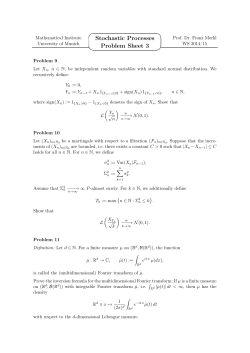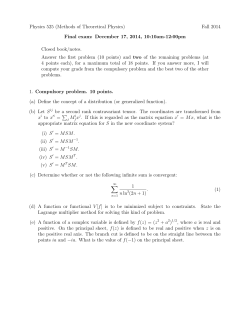
More Practice Problems November 18, 2014
More Practice Problems
November 18, 2014
There’s nothing to hand in, these are optional, and an opportunity for those of you wishing to work on
more problems. I suggest also reviewing previous recommended & required problems from throughout the
course since the final exam is cumulative.
1. Find the general solution of
utt (x, t) + 2uxt = 3uxx (x, t)
and use your answer to solve the following PDE IBVP
utt (x, t) + 2uxt = 3uxx (x, t),
u(x, 0) = f (x),
ut (x, 0) = g(x)
(x, t) ∈ R × R+
x∈R
x∈R
2. Make sure you review properties of harmonic functions, like those properties we discussed in lecture
and on problem set #5.
3.
• Given a positive function f (x) satisfying lim|x|→∞ f (x) = 0 define the function Bθ (x) via
Z ∞
.
Bθ (x) =
f (x + sθθ )ds
0
Evaluate
θ · ∇Bθ (x)
where θ is a fixed constant unit vector in Rn .
.
• The unit vector θ defines a“hyperplane” Πθ = {y ∈ Rn ; y · θ = 0} for which it constitutes a unit
n
normal vector. I claim that any x ∈ R can be written uniquely in terms of the unit vector θ and
a vector in Πθ , i.e.
x = tθθ + pv,
v ∈ Πθ
Use the above decomposition of x to determine the following two limits
lim Bθ (tθθ + pv),
and
t→−∞
lim Bθ (tθθ + pv)
t→+∞
4. Consider
ρutt = T0 uxx + αu,
x ∈ (0, L),
t>0
for ρ(x) > 0, α(x) < 0 and T0 a constant, subject to the boundary conditions
u(0, t) = u(L, t) = 0,
t>0
and initial conditions
u(x, 0) = f (x),
ut (x, 0) = g(x)
Solve this equation in terms of eigenfunctions, determining all necessary constants, and state what the
equation models.
1
5. Derive an integral formula for the solution ψ(x, t) to the following initial value problem for the
Schr¨
odinger equation (used to describe the evolution of a free quantum particle of mass m in 1 space
dimension)
~2 ∂ψ
∂ψ
i~
, x ∈ R, t ≥ 0,
=−
∂t
2m ∂x2
Z ∞
Z
ψ(x, 0) = f (x), with
|f (x)|2 dx = 1 and
−∞
(1)
∞
|f (x)|dx < ∞.
−∞
6. For the following, we denote by F the Fourier transform.
(a) True or false: Fx→ω (f (x)g(x)) = (Ff )(ω)(Fg)(ω)
(b) Show the following scaling property of the Fourier transform:
Fx→ω f (ax) =
1
ω
(Fx→ω f )( )
a
a
(c) If f is real-valued, show that
F[f ](−ω) = F[f ](ω)
(d) Suppose that L is a linear constant-coefficient differential operator. The Green’s function satisfies
Lx G(x; x0 ) = δ(x − x0 )
What equation does the n-dimensional Fourier transform of the Green’s function
Fx→ωω [G(x; x0 )]
satisfy? Use your answer to write down G(x; x0 ), formally.
(e) Show that, for H(x) the Heaviside function, one has
Fx→ω (H(a − |x|)) =
2 sin aω
ω
The RHS of the above is sometimes called a since function. The FT of a box is a sinc.
(f) Suppose we wanted to solve the constant speed wave equation
utt = c2 uxx ,
(t, x) ∈ R>0 × R
subject to
u(0, x) = f (x),
ut (0, x) = g(x)
We solved this earlier and got d’Albembert’s formula. This time, solve this by taking the Fourier
transform of the equation in the x variable only. To do this take the Fourier transform of the
PDE with respect to the x variable to reduce the PDE to a new PDE (actually it will look more
like an ODE) for the Fourier transform Fx→ω [u](t, ω). Then solve this equation to get the Fourier
transform of the solution to the original PDE. Once you have that you can invert the Fourier
transform and, if you’ve done everything correctly, you should recover the d’Alembert formula.
For this last step you will need the identity established in part (e).
2
© Copyright 2025





















